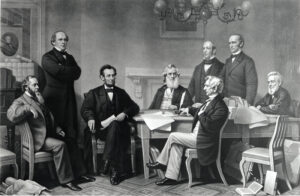The evolution of the Emancipation Proclamation

Here’s more of the story. Hello, I’m Susannah Koerber, Chief Curator and Research Officer at the Indiana State Museum and Historic Sites. And I’ll be talking about Lincoln’s changes to the Emancipation Proclamation. In July 1862, President Abraham Lincoln read his cabinet a proclamation he had just written. It would make clear that the Civil War was a war not just for the preservation of the Union but also against slavery. This was the preliminary Emancipation Proclamation, freeing all enslaved persons who were in areas under the Confederate government. His Cabinet suggested that he wait until a Union victory to issue the Proclamation. Lincoln was always sensitive to public opinion in the context of a war he had to win. He knew the Proclamation would be controversial, so in the meantime he began to prepare the public. He used the press to signal that he was more conservative on the issue than he really was. He met with prominent Black members of the Washington, DC community to promote the hotly debated topic of colonization, which encouraged free Blacks to move out of the United States rather than securing their rights here. He also wrote a highly publicized letter in response to a New York Tribune editorial, saying, If I could save the Union without freeing any slave I would do it, and if I could save it by freeing all the slaves I would do it; and if I could save it by freeing some and leaving others alone I would also do that. He was quickly attacked by the editorial writer, Horace Greeley, and Frederick Douglass and others who interpreted it as saying that he did not care about the enslaved. Lincoln, however, knew he was about to start dismantling slavery. The preliminary Emancipation Proclamation was finally issued on September 22, after the battle of Antietam. Those who hated slavery celebrated it, realizing that Lincoln was now committing the nation to a path that would end the institution. In it, he gave the Confederacy 100 days to surrender, or those people they enslaved would be freed. During those 100 days, Lincoln met both publicly and privately with Black leaders and their allies who argued for making the final Proclamation more radical. These included Robert Smalls, who had just become a national hero by piloting the Confederate ship on which he was an enslaved crewmember out of Charleston Harbor and into the hands of the U.S. Navy. When Lincoln signed the Emancipation Proclamation on January 1, 1863, it had two major changes that those leaders had advocated: there was no mention of colonization and it enabled Black troops to enlist in the U.S. military, giving them the right to fight to end slavery, save the Union, and advocate for their citizenship. Almost 200,000 would serve in the Army and Navy before the war’s end.









